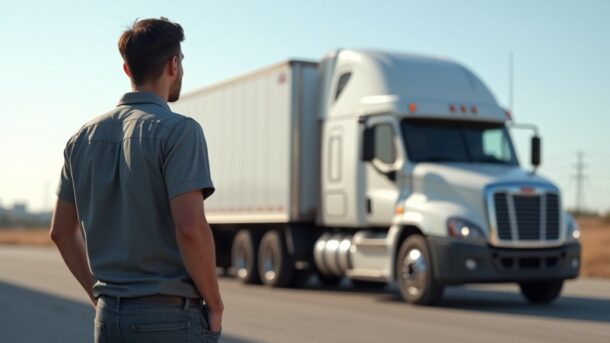Most people think of driving as something you do in a regular car. But sitting behind the wheel of a big truck is a completely different experience. These vehicles are massive, and they handle nothing like a car. That’s why truck driving schools exist — they make sure drivers know exactly what they’re doing before they hit the road on their own.
Starting Off in the Classroom
The first step in truck driving school usually isn’t jumping straight into the driver’s seat. It begins in a classroom, where learners go over the basics. You get to understand how the trucks work, the rules for heavy vehicles, and the safety checks that keep everyone on the road safe.
At first, it might feel a bit slow compared to the idea of driving right away, but this part makes a huge difference later on. Knowing how a truck reacts to heavy loads, why it needs more space to turn, and what signs to pay attention to gives you a solid base before you ever move the truck an inch.
If you want to learn somewhere that makes these early lessons clear and not overwhelming, the Blue Horse Truck Driving Training School is known for guiding people through step by step until they feel ready to get behind the wheel.
Meeting the Truck for the First Time
Once the basics are out of the way, it’s time to get up close with the vehicle. This part usually surprises people, because everything about a truck feels bigger. Climbing into the driver’s seat is higher up, the mirrors are huge, and the steering wheel feels a lot larger than what most are used to.
Before going anywhere, students learn to check the truck over properly. This is called a pre-trip inspection. It involves looking at the tyres, lights, brakes, and other important parts to make sure everything’s safe. It might seem like a long list, but it’s one of the most important habits to build. A quick check can prevent serious problems later on.
Learning the Gears
One of the biggest changes from driving a car is learning how to handle the gears. Many trucks use manual gearboxes, and they usually have way more gears than a normal car. At first, shifting can feel a little awkward, but instructors break it down so learners pick it up quickly.
Some schools also teach automatic trucks, which are easier to drive. But even when that’s the case, learning manual is often encouraged because it helps you really understand how the truck works.
Practice in a Safe Space
Nobody gets thrown straight into traffic. Training first takes place in safe practice areas. These are quiet spots where learners can focus on steering, parking, reversing, and handling corners without worrying about other cars around them.
Reversing is usually the hardest part to learn. Trucks don’t move in reverse the same way cars do, and it can feel confusing at first. Instructors stay patient and guide each move until students get the hang of it. Over time, it starts to feel natural.
Taking It Out on the Road
Once learners have enough practice in the yard, they’re ready to take the truck onto real roads. This is the part that feels the most exciting, but also the most nerve-racking at first. The instructor rides along the whole time, making sure everything’s under control.
On the road, students practice things like merging onto highways, turning at intersections, and controlling the truck on hills. They also learn defensive driving, which basically means keeping a safe distance, paying attention to what’s happening around them, and being prepared if someone else on the road makes a mistake.
How to Handle Loads Safely
Driving the truck is only half the job. The other half is making sure the loads it carries are safe and secure. In training, students learn how to check that everything is strapped down properly and balanced so the truck doesn’t lean or shift while moving.
This part might not sound as exciting as driving, but it’s extremely important. If a heavy load moves, it can cause the truck to tip or make it harder to stop. Knowing how to secure loads correctly is a skill that every truck driver needs.
Rules Every Truck Driver Follows
Truck drivers follow some of the strictest rules on the road. Driving schools make sure students understand these from the start. There are limits on how many hours someone can drive before they must take a break, and keeping a logbook is usually required. Learners also go over weight restrictions, speed limits for heavy vehicles, and safety distances.
Schools also prepare students for tricky situations like breakdowns or driving in bad weather. Knowing how to stay calm and make the right decisions in these moments is part of what makes a good truck driver.
Getting Ready for the Licence Test
Everything in truck driving school leads up to the big test. This usually includes both a written part and a practical driving test. The written section covers the rules and safety information, while the driving test checks if the student can control the truck properly.
Instructors usually run through practice tests so learners know what to expect. By the time the real test comes around, most people feel ready instead of nervous because they’ve been given so much support and practice.
Why Training Makes Such a Difference
Truck drivers are a big part of everyday life. Almost everything we use — from groceries to building materials — gets delivered by truck. That’s why learning to drive them the right way is such a big deal. Training isn’t just about passing a test; it’s about being safe on the road and keeping others safe too.
What to Remember
Truck driving school covers way more than just steering a huge vehicle. Learners go through everything from safety checks and gears to road rules and handling loads. They start in the classroom, then move step by step into real driving until they feel confident.
It takes effort and focus, but the reward is a skill that can lead to a strong career and a lot of independence. For anyone thinking about giving it a go, it’s not as scary as it sounds — especially with the right training and support.




